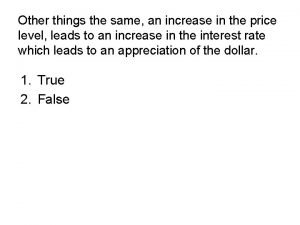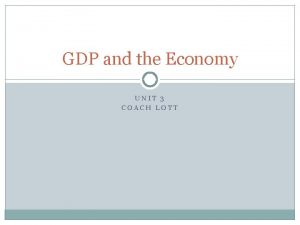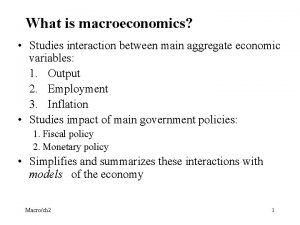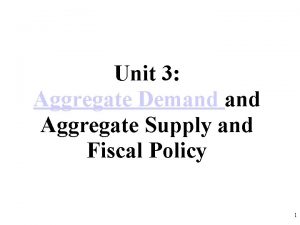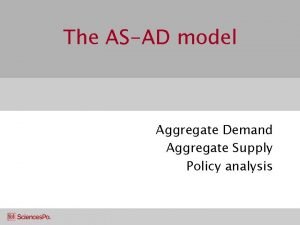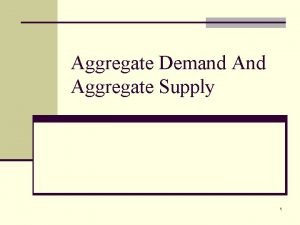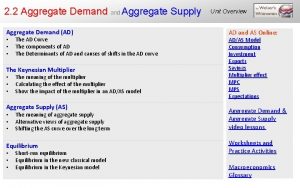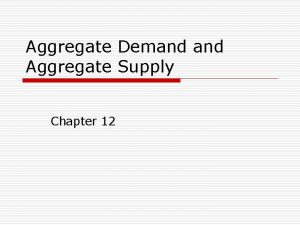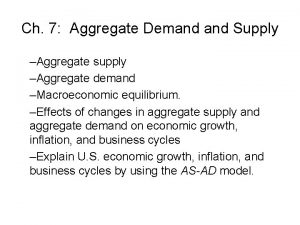Aggregate Supply Aggregate Demand Ch 13 Aggregate Supply
























- Slides: 24

Aggregate Supply & Aggregate Demand Ch. 13 Aggregate Supply 1

Aggregate Supply & Aggregate Demand Model • The purpose of that model is to explain how real GDP and the price level are determined. • It is similar to the market equilibrium in a competitive market. But there are some differences because AS-AD model is a model of imaginary market of how real GDP & the general price level( measured by the GDP price Index) are determined. 2

Aggregate Supply • The quantity of real GDP supplied is the total amount of final goods and services that firms in the country plan to produce. • It depends on the quantities of: 1. Labor employed. 2. Capital, human capital , and the state of technology. 3. Land natural resources. 4. Entrepreneurial talent. 3

AS-AD Model • It explains the fluctuations of real GDP around potential GDP. • Real GDP fluctuates around potential GDP because the quantity of labor employed fluctuates around its full employment level. 4

At full employment real GDP = potential GDP where Capital, human capital , the state of technology, the quantity of land natural resources, and the entrepreneurial talent are fixed. • In the labor market , equilibrium happens and the quantity of labor employed is determined when the quantity of labor demanded = the quantity of labor supplied at the equilibrium real wage rate. 5

Aggregate Supply Basics • Aggregate Supply is the relationship between the quantity of real GDP supplied and the price level (when all other influences on production plans remain the same. ) 6

The Relationship Between the Quantity of Real GDP Supplied and the Price Level • There is direct relation between the price level and real GDPsupplied. 7

Aggregate Supply Schedule • It shows the direct relationship between real GDP supplied and the price level , other things being constant. Price level ( GDP Price Index ) 2005=100 Quantity of real GDP supplied Trillions of 2005 dollars E 120 14. 0 D 115 13. 5 C 110 13. 5 B 105 12. 5 A 100 12. 0 P 8

Aggregate Supply Curve Price 130 Level 120 Potential GDP Real GDP E D C 110 B 100 A Real GDP below Potential GDP 90 0 9 Real GDP above Potential GDP 12 13 Real GDP Supplied 14 15

Other Influences Being Constant • Beside other influences being constant that mentioned before , we add two things remain constant along the supply curve: q The money wage rate. q. The money prices of other resources. 10

Why the AS Curve Slopes Upward? The answer is: If the price level rises , the real wage rate falls ( assuming money wages constant) Firms will increase the quantity of labor employed and the level of production, and vice versa. 11

What is Real Wage Rate? • • 12 Real wage rate shows how much the money wage rate buys goods and services. The Real Wage Rate= the money wage rate divided by the price level ( GDP price index) If the money wage rate denoted by W and, If the price level denoted by P Then;

For the Economy as a Whole: Employment and Real GDP Change When the Price Level Changes • There are three ways in which these changes occur: 1. Firms change their output rate. (price level increases, this leads to an increase in real GDP and vice versa) 2. Firms shut down temporarily or restart production. (price level increases, this leads to an increase in real GDP and vice versa) 3. Firms go out of business or start up in business(price level increases, this leads to an increase in real GDP and vice versa). 13

1. Change in Output Rate • To change its output rate , a firm must change the quantity of labor that it employs. • If the additional labor costs less than the revenue the firm generates, it is profitable to hire more labor. • So if the price level rises and the money wage rate doesn’t change ( real wage rate decreases) an extra hour of labor becomes profitable and both the quantity of labor demanded and production increase and vice versa. 14

2. Temporary Shutdowns and Restarts • A firm that is incurring a loss might decide to shut down temporarily and lay off its workers even it might foresee a profit in the future. . • So if the price level rises relative to wages , fewer firms decide to shut down temporarily; more firms operate and the quantity of real GDP supplied increases. And vice versa. 15

3. Business Failure and Startup • People create businesses to earn profits. • When profits are high , fewer firms fail and more firms start up. The number of firms increases. and vice versa. 16

• So if the price level rises relative to wages , profits increase , the number of firms in business increase, and the quantity of real GDP supplied increases. And vice versa. 17

Changes in Aggregate Supply • Aggregate supply changes when any influence on production plans other than price level changes. • Aggregate supply changes when: 1) Potential GDP changes. 2) The money wage rate changes. 3) The money prices of other resources change. 18

Change in Potential GDP • If potential GDP increases then potential GDP line shifts from (1) to (2) and AS curve shift to the right from AS 1 to AS 2 , as its shown in this figure, and vice versa. 19

Initial (1) Potential GDP Price Level 130 new (2)Potential GDP AS 1 AS 2 120 C C” 110 100 90 0 20 12 13 14 Real GDP Supplied 15

Changes in Money Wage Rate • A change in the money wage rate changes aggregate supply because it changes firm’s costs. The higher the money wage rate, the higher are the firms’ costs and the smaller is the quantity that firms are willing to supply at each price level. • An increase in money wage a decrease in the aggregate supply curve and vice versa. 21

The effect of the increase in the money wage rate , if the potential GDP does not change The following figure shows : A rise in the money wage rate( the real wage rate is the same ) , decreases the aggregate supply curve and does not affect the potential GDP. 22

Price Level Potential GDP AS 1 AS 0 D 120 C 110 100 90 23 0 11. 5 12 13 14 15 Real GDP

Change in Money Prices of Other Resources • A change in money prices of other resources has the same effect on firms’ production plans as a change in the money wage rate. It changes firms’ costs. • If the money prices of other resources rise , the price level is the same , the real costs change and the quantity that firms are willing to supply decreases at each price level ( AS shifts to the left ). 24
 Unit 3 aggregate demand aggregate supply and fiscal policy
Unit 3 aggregate demand aggregate supply and fiscal policy Shift in sras curve
Shift in sras curve Unit 3 aggregate demand aggregate supply and fiscal policy
Unit 3 aggregate demand aggregate supply and fiscal policy How to calculate aggregate demand
How to calculate aggregate demand Aggregate supply shifters
Aggregate supply shifters Aggregate demand supply graph
Aggregate demand supply graph Aggregate planning strategies
Aggregate planning strategies Aggregate supply shifters
Aggregate supply shifters Aggregate supply shocks
Aggregate supply shocks Module 5 supply and demand introduction and demand
Module 5 supply and demand introduction and demand Matching supply with demand
Matching supply with demand Cannot mix aggregate and non aggregate tableau
Cannot mix aggregate and non aggregate tableau Which of the following shifts aggregate demand to the left?
Which of the following shifts aggregate demand to the left? Aggregate demand curve
Aggregate demand curve Fisher's equation
Fisher's equation Money market graph expansionary monetary policy
Money market graph expansionary monetary policy Recessionary gap aggregate demand
Recessionary gap aggregate demand What is nominal gdp
What is nominal gdp Why is aggregate demand downward sloping
Why is aggregate demand downward sloping The aggregate real money demand schedule l(r,y)
The aggregate real money demand schedule l(r,y) Aggregate demand graph
Aggregate demand graph Asad model
Asad model The aggregate real money demand schedule l(r,y)
The aggregate real money demand schedule l(r,y) Types of demand forecasting in managerial economics
Types of demand forecasting in managerial economics Dependent and independent demand in inventory management
Dependent and independent demand in inventory management












